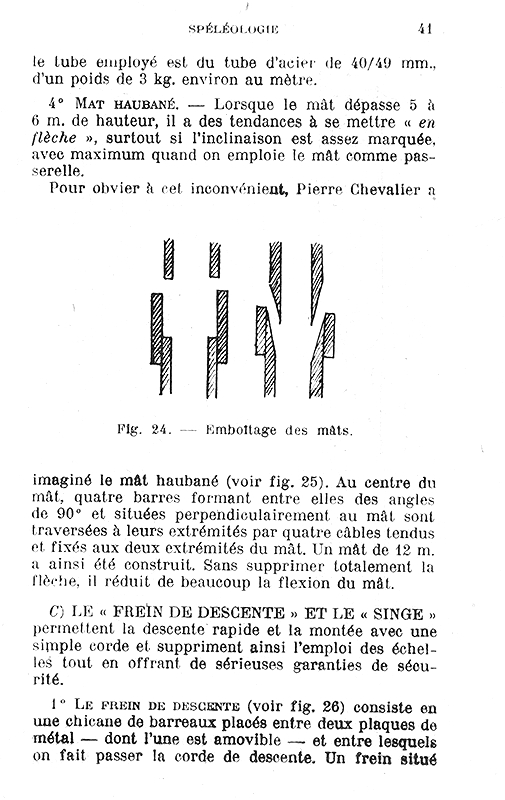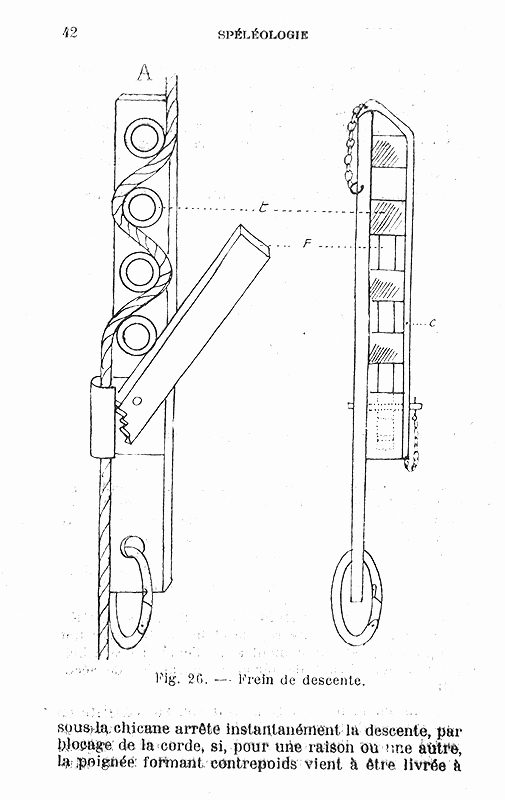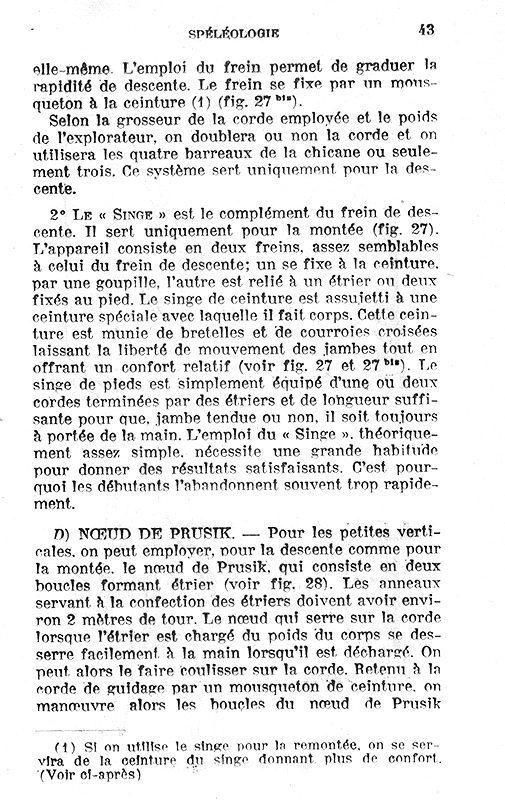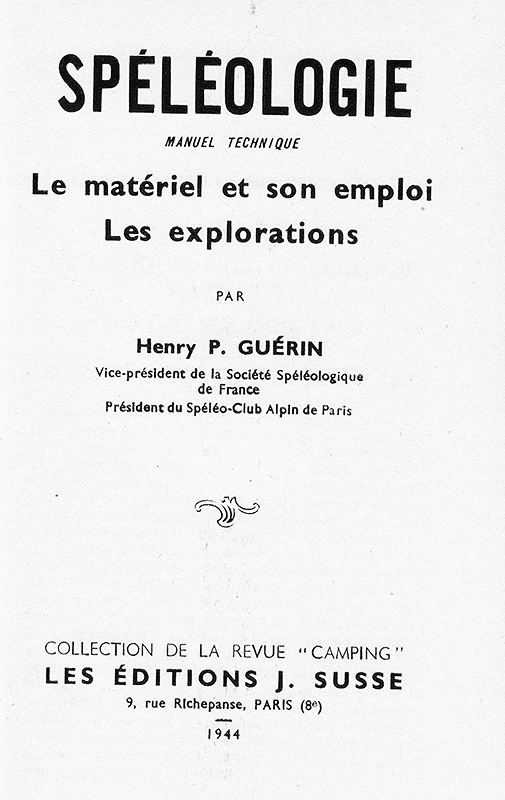Overview
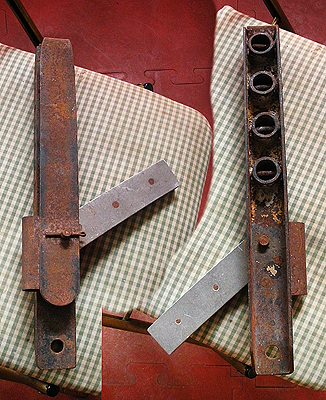 Henri Brenot developed a descender for use in the Pyrenees Caves in 1933, and Henry P. Guérin illustrated it in his 1944 book “Spéléologie Le Matériel et son emploi Les explorations."). Sadly, the book did not contain photographs of the device, merely including a crude sketch.
Henri Brenot developed a descender for use in the Pyrenees Caves in 1933, and Henry P. Guérin illustrated it in his 1944 book “Spéléologie Le Matériel et son emploi Les explorations."). Sadly, the book did not contain photographs of the device, merely including a crude sketch.
Fortunately, Jean-Luc Lamouroux posted pictures of one on FaceBook. Jean-Luc’s pictures, now deleted, included two views of an original Brenot. The front view showed a closed descender, and the handle cam face was not visible. The rear view showed an interesting riveted construction. There was no side view photograph, so I was not able to determine for what size rope the device was made.
I later found another picture in the Musée du Matériel Spéléo website, That showed a side view and suggested that the original was sized for 20 mm. rope. I found that picture after I made my versions, both of which were sized for 13 mm. rope.
The Brenot is of great historical interest, but its day as a state-of-the-art caving descender is long past.
[ Top
| Version B
| Return to Misc. Descenders
]
Version A
(#3280)
Technical Details
I made this descender in 2023. Amy Skowronski did the welding for me.
This Storrick - Brenot descender is 371 mm. tall, 100 mm. wide, 50 mm. thick, and weighs 2153 g.
The frame is 2" (50 mm) steel channel. Four 1" (25 mm.) x 1/8" wall 1018 tubular bollards are welded to the frame. Below this, a rope channel made from 1/8" x 2" 1018 is welded in place. The eye is 9/16" (14 mm.). Opposite the rope channel is a hand brake made from 1-1/2" x 1/2" (38 mm x 12.7 mm.) 1018. It pivots on a 3/8" (9.5 mm) 4140 pin secured with a hair pin. The cover is 2" x 1/8" 1018.
I stamped my logo on the cover.
I based this version on Figure 26 from Henry P. Guérin's 1944 book "Spéléologie Le Matériel et son emploi Les explorations." I chose to have Amy Skowronski weld the bollards to the frame. I extended the front cover so that it is captured by the harness carabiner. Finally, it appeared that the rope would run against the edge of the cover, so I provided a clearance notch.
In operation, the Brenot works much like a Fixed Multibar Descender with a braking handle beneath. The bollards provide about the same friction as a three-slot whaletail. I prefer to brake in a traditional manner rather than using the braking handle, but that is hardly fair - the Brenot predated traditional rappel braking. Being made of steel, the Brenot is quite heavy, and the handle mechanism is responsible for about a third of that weight.
The Brenot was designed in the era of natural fiber ropes, which were much heavier than modern ropes, and so the descender weight was of less concern.
[ Top
| Version A
| Return to Misc. Descenders
]
Version B
(#3374)
Technical Details
I made this descender in 2024
This Storrick - Brenot descender is 367 mm. tall, 109 mm. wide, 62 mm. thick, and weighs 1411 g.
I made the frame by removing one side of 1-1/2 inch (38 mm) hollow steel tubing. Four 1" (25 mm.) x 1/8" wall 1018 tubular bollards are riveted to the frame. Below this, a rope channel made from 1/8" x 2" 1018 is riveted in place. The eye is 9/16" (14 mm.). Opposite the rope channel is a hand brake made from 1-1/2" x 1/2" (38 mm x 12.7 mm.) 6061-T6. It pivots on a 5/16" (7.9 mm) pin made from a grade 5 bolt. The pin secured with a hair pin. The cover is 2" x 1/8" 1018.
I stamped my logo on the handle.
I based this version on Jean-Luc's photos of the one in the Musée du Matériel Spéléo. Riveting the bollards in place presented an initial challenge – an unsupported 2-inch (50 mm.) long, 1/8 inch (4 mm.) diameter rivet would rather bend than accept having a a head beaten onto it. I created a jig to support the rivets as I wailed on them
The Musée du Matériel Spéléo device used three thin plates riveted to form a laminated brake. I made my brake out of ½-inch (12.7 mm) 6061-T6 plate since I had thicker material available. The rest of the construction is similar to my first version.
My Brenot Descenders each separate into five pieces, two of which are easily misplaced. I chose to chain the pieces together in my first version. I did not do so in this one because the original in the Musée du Matériel Spéléo had not done so.
[ Top
| Version A
| Version B
]



